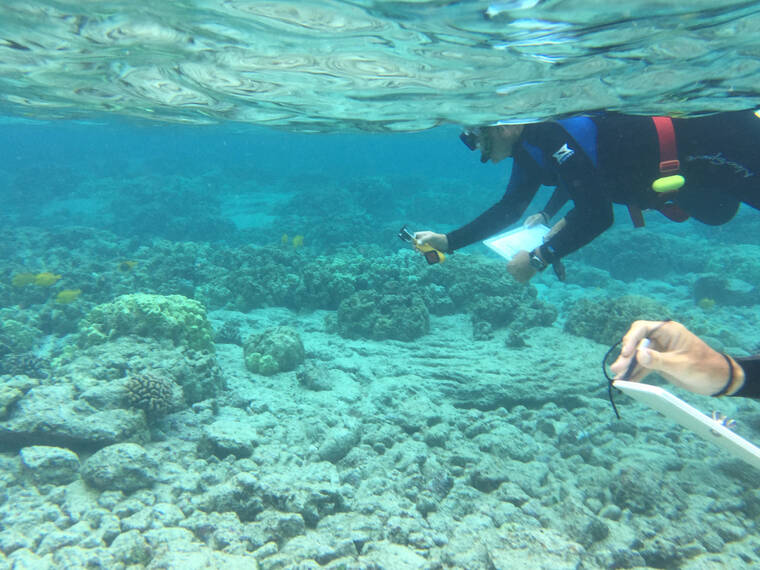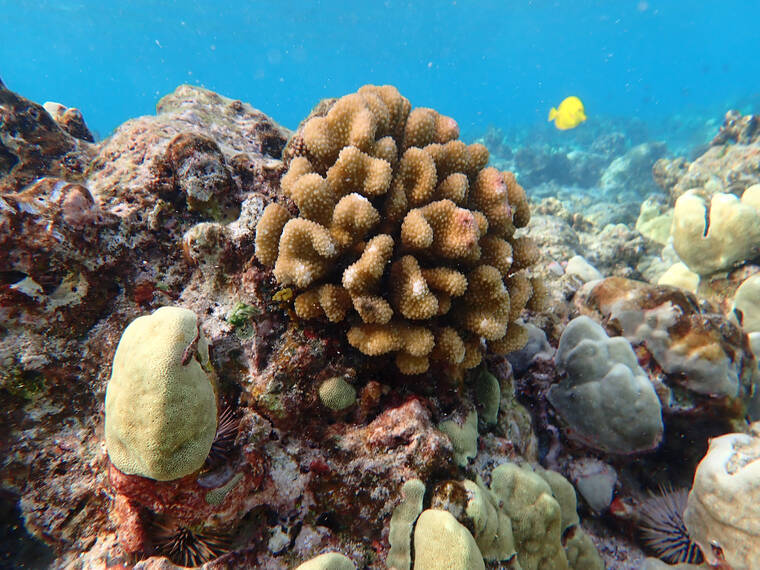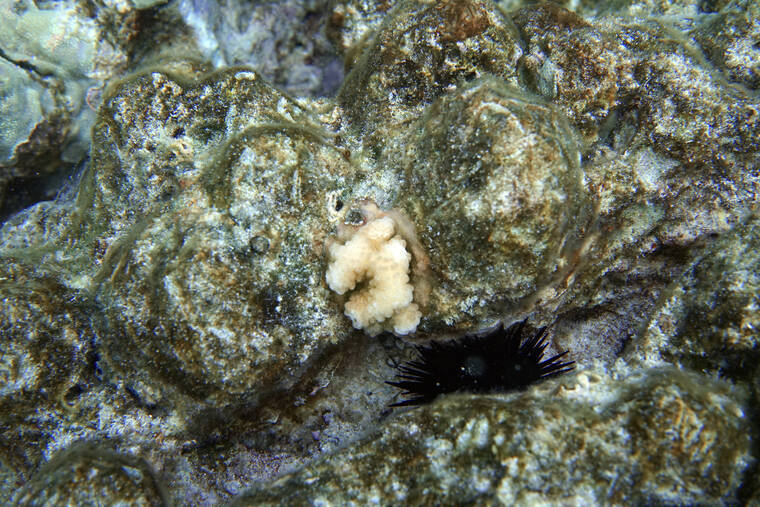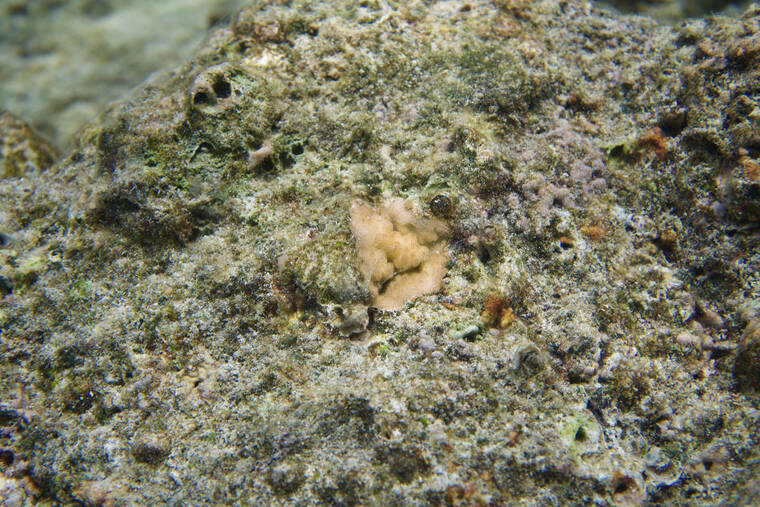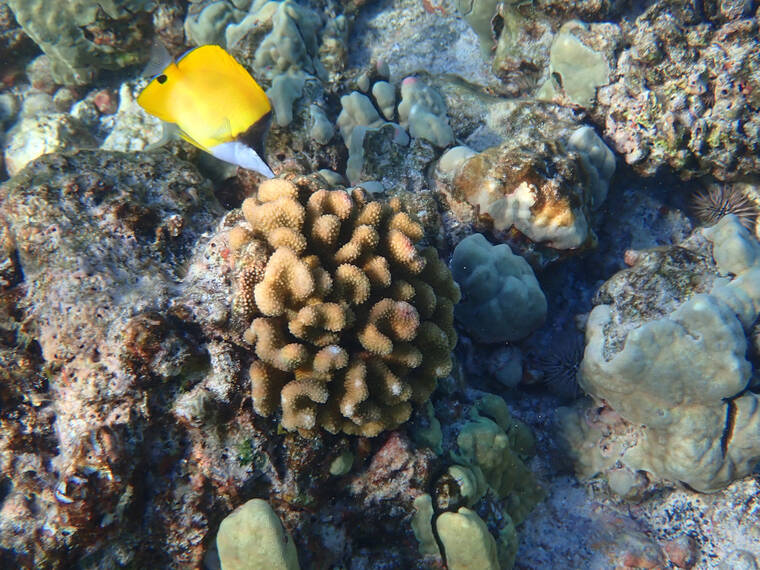Hawaii Island’s Kahalu‘u Beach Park will be closed next week to beach- and oceangoers alike for anticipated coral spawning events and to give the popular site a rest from “chronic daily use.”
Closing the park for spawning is essential for the coral to recover from major population loss, according to The Kahalu‘u Bay Education Center, a partnership between Hawaii County and nonprofit The Kohala Center to revive and revitalize the heavily used bay. Closures have been taking place since 2018, and results of the annual “time outs” for the bay are visible.
From 2015 to 2019, nearly 90% of the cauliflower coral (Pocillopora meandrina) population at Kahalu‘u Beach Park was lost to bleaching events triggered by high water temperatures and chronic stressors, such as human use.
“The bay once was dotted by hundreds of cauliflower coral, which provide structural integrity to the reef. They’re an important species on the reef. But Kahalu‘u Beach is more susceptible to stress because it doesn’t have an open flow of water, so we saw severe bleaching,” said Kathleen Clark, Marine Stewardship and Education Specialist for the center.
Clark emphasized the importance of giving the cauliflower coral the Monday, May 16, through Saturday, May 22, rest period to recuperate and regrow.
“This rest period is a great thing we can do to give places like Kahalu‘u a break from the chronic stress of daily human use. Coral spawning is one of those examples, but the bigger picture, what was apparent was the coral needs rest periods,” Clark continued. “It’s a way for us to give back and let ecosystems provide the community with benefits.”
During spawning events, corals emit reproductive cells into the water, which the tides carry to mix and generate planktonic coral larvae. During such events, the bay will be a milky color, the result of male and female gametes emitting at the same time.
Closing the bay to people during spawning helps reduce harm to corals from people physically disturbing the animals or using chemicals, such as sunscreen, that can impact the bay’s waters. It also increases the likelihood that coral larvae will settle and grow in the bay.
Since the start of the coral spawning closures, which began as two half-day closures in 2018 that’s expanded to a weeklong “rest period” for the bay, coral has been able to grow back. Coral as young as a year old has been spotted at Kahalu‘u Bay.
“Through the great work of The Kohala Center and their efforts to educate visitors and protect the reefs, we have seen extremely positive results by closing the park yearly for coral spawning,” said Cyrus Johnasen, spokesman for Hawaii County. “In fact, coral that would have otherwise died have been able to bounce back in abundance, ultimately supporting the surrounding sea life and pristine ecosystem.”
Most people at the beach on a recent day were excited about the closure.
Leslie Taylor, who has been visiting the Big Island and Kahalu‘u for over 20 years, agreed the closure is worth the loss of a week’s access to the bay’s colorful fish and dazzling coral colonies.
“I think it’s great they’re shutting the beach down. It saddens me to see people standing close to new coral markers. I would volunteer here if I lived here. It’s great they’re going to close it.”
For her, Kahalu‘u is a special place.
“It’s such a wonderful and safe place,” she said. “Last year, I brought my 5-year-old nephew here, we we’re snorkeling in the ocean, I loved watching him see all the fish. I also find peace here, floating around.”
Another beachgoer agreed.
“I think anything to keep the coral healthy is great. Obviously, I love being able to come and look at the fish, but if it was to save the reef and we needed to close it forever, I’d support that, too,” said Catherine Reid, a Kahalu‘u beachgoer. “I read there’s lots of snorkeling beaches here. Maybe they could alternate closing?”
While the county believes coral spawning closures are something that can be replicated elsewhere, such a move is not yet in the works.
“Although no other closures are projected at this moment, we have reached out to varying communities and have begun the conversation of temporary closures as they relate to health and longevity of our most cherished places. These places are what make Hawaii special and we are committed to their preservation. If closures can help us to reach that goal, we are open” Johnasen said.
During the May 16 to 21 closure, lifeguards will remain on duty though the park will be closed to users.







